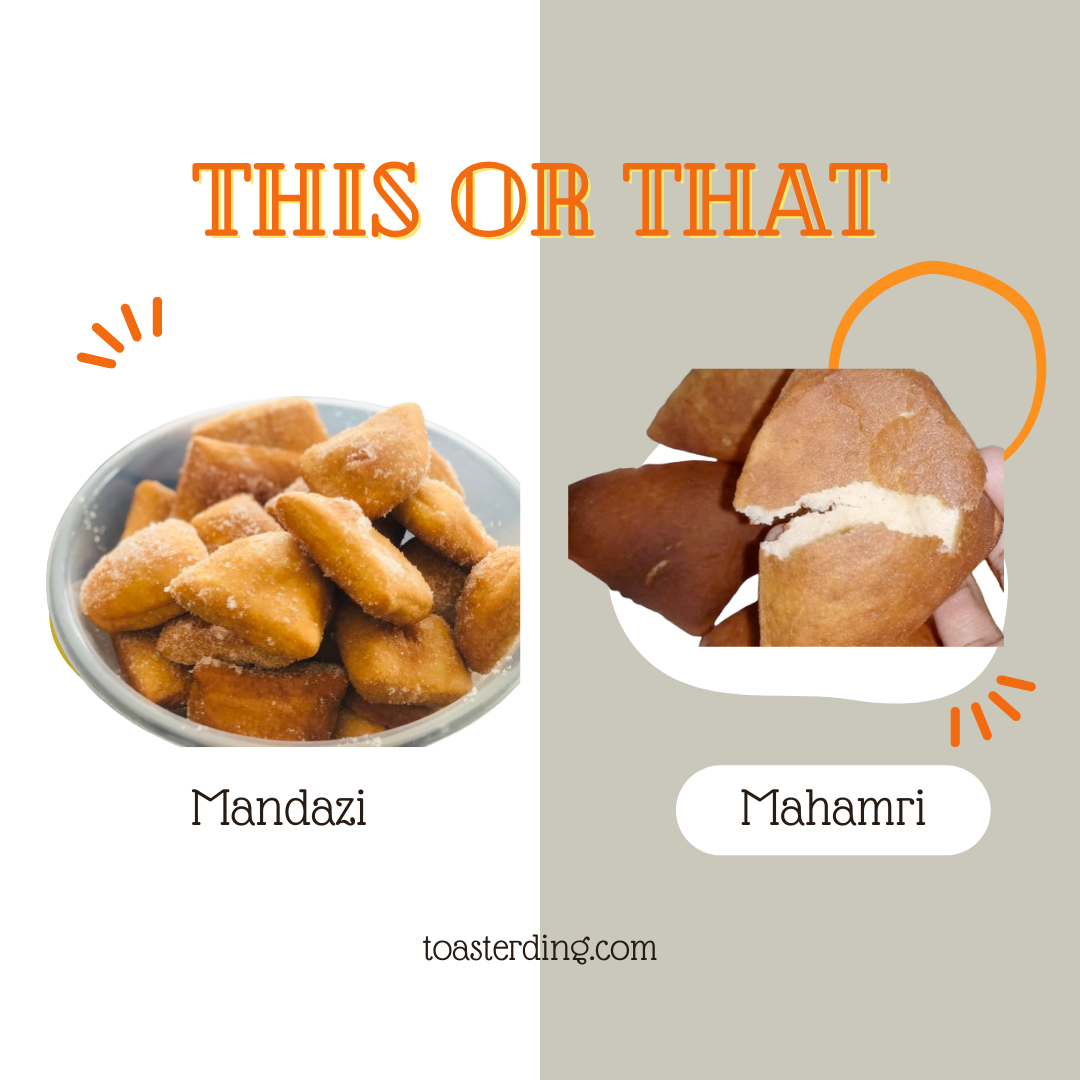Mahamri and Mandazi are both popular fried bread snacks in East Africa, notably in Kenya and Tanzania. While they share alot of differences that most people can’t tell them, apart, in this post we will do exactly that, highlight the similarities and differences between Mandazi and Mahamri
Appearance

Distinguishing between Mahamri and Mandazi based solely on appearance can be challenging. They are often cut into similar shapes and cooked to the same golden brown hue, making it difficult to differentiate them at a glance.
This is why many people confuse them based on appearance alone. Both are commonly cut into triangular shapes, but Mahamri typically adheres strictly to this shape.
Mandazi, on the other hand, comes in various shapes and sizes, though the classic version resembles a triangle-like Mahamri. However, Mandazi can also be found in rectangular shapes.

So, in summary, Mahamri are normally triangular while for mandazi you have the flexibility to choose any shape, triangular rectangular, or even cubes
Texture

Mahamri typically has a hollow interior, while Mandazi is solid inside, offering a denser, fluffier, and more pillowy texture. However, Mandazi can be made hollow by adjusting the amount of raising agents and rolling the dough thinly, providing more flexibility in texture.
As a result, Mandazi tends to be more filling than Mahamri. With Mahamri, the enjoyment lies in the crisp exterior, whereas Mandazi offers a combination of a soft interior and a crispy exterior.
If you appreciate varying textures, Mandazi would be the preferred choice.
Rising Agents

Mahamri relies on natural yeast as a leavening agent, whereas Mandazi typically utilizes chemical raising agents such as baking powder or bicarbonate of soda (baking soda).
Mahamri made with natural yeast often have a distinct, traditional flavor that comes from the fermentation process. This gives them a unique taste which is better than Mandazi, also using yeast mahamri offers a chewier or more elastic result.
Mandazi made with chemical raising agents like baking powder or baking soda offer more consistent results in terms of texture and rise, as they don’t rely on fermentation processes that environmental factors can influence, so it is easier to rise mandazis than mahamris
Flour Choice

Mahamri typically utilizes all-purpose flour, whereas Mandazi is commonly made with self-raising or specialized Mandazi flour that already contains baking powder.
This makes Mandazi more convenient as it provides a ready-to-use flour mix. However, adjustments may be necessary as the amount of baking powder in Mandazi flour might not always be sufficient to achieve the desired level of rise in your Mandazi.
Liquids Used

Mahamri typically utilizes coconut milk, while Mandazi commonly employs water or cow’s milk. Because Mahamri incorporates yeast, the liquid used must be at an optimal temperature—warm coconut milk, ideally not exceeding 40 degrees Celsius, to activate the yeast without denaturing it, as yeast are living organisms.
Using coconut milk at a low temperature won’t activate the yeast, resulting in Mahamri failing to rise. Hence, Mahamri are more delicate and technically demanding to prepare compared to Mandazi due to this requirement.
In contrast, for Mandazi, you have more freedom regarding the temperature of the liquid used, whether it’s milk or water. Additionally, since baking powder serves as a chemical leavening agent in Mandazi, it doesn’t have an optimum temperature requirement.
Furthermore, in Mandazi, you can include butter or margarine to impart softness, a flexibility not available in Mahamri.
Spices

Mahamri recipes typically include ground cardamom powder mixed into the flour during dough preparation.
Conversely, Mandazi recipes don’t necessitate any spices, though cinnamon or nutmeg can be delightful additions if desired. Moreover, Mandazi offers more flexibility for personalization, allowing for the inclusion of lemon zest for a variation known as lemon Mandazi.
This means Mandazi can either be kept simple without spices or customized with various flavor enhancements. While spices are optional in Mandazi, they’re essential in Mahamri recipes for authentic flavor
Serving Suggestions
Mandazi is predominantly consumed as a breakfast accompaniment, with approximately 95% of the population enjoying it in this manner.
Some individuals may also be satisfied with Mandazi as a snack, while others may incorporate it into dishes like Githeri by shredding and adding it, as commonly practiced during high school. Typically, Mandazi is paired with milk tea, enhancing its morning appeal.
Contrastingly, Mahamri is often served alongside pojo, a green gram stew prepared with coconut milk. However, this doesn’t restrict Mahamri’s versatility, as they can also be enjoyed with tea, similar to how Mandazi is consumed.
Also Read: Coconut Green Grams Recipe: (Ndengu / Pojo)
Thus, while Mahamri traditionally complements pojo, it can also serve as a delightful accompaniment to a comforting cup of tea.
Thoughts?
So, to sum up, I hope you found this information insightful, profound, and, above all, helpful in addressing your query. Mandazis are the preferred choice between the two because they’re simple to prepare, don’t demand extra ingredients, and require minimal effort.
If you’re just starting out, I suggest beginning with mandazis to increase your chances of success when attempting mahamri.
I’m not an expert in either, so I’ll include links to my straightforward simple recipes for both below. Thanks for your participation, and I’ll catch you in the next post!
Related Links
Mandazi For Beginners Recipe: No Milk, No Eggs
Authentic Mahamri Recipe: With Cardamom
Sweet & Soft Mandazi Bites Recipe: Literally Bite-Sized

